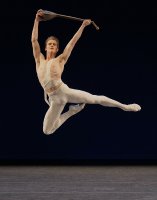By Rachel Straus
At the most recent Guggenheim Museum Works & Process (September 23), I couldn’t help but think of Monte Carlo in 1928. In that city and year, the 24-year-old George Balanchine created his bedrock neo-classical ballet to Stravinsky’s Apollon musagète. For the next four decades, the partnership between the young Russian choreographer and older Russian composer flourished.
At Sunday’s moderated talk and dance exhibition, the subject was a new ballet-music partnership—that of the 25-year-old American choreographer Justin Peck and American indie rocker Sufjan Stevens. Peck is a current New York City Ballet corps member who has been making work since 2009. Stevens has several award winning albums under his belt. Moderator Ellen Bar mentioned that Stevens has a “cult following.” The hope is that his music will bring in a new, young audience to New York City Ballet. On October 3 the Peck-Stevens work, Year of the Rabbit, will premiere at the former New York State Theater.
What’s odd about this new collaboration is that Stevens’s 2001 electronica album Enjoy Your Rabbit is getting a complete classical music makeover. In fact, Rabbit has been through not one but two iterations since its inception. Classical music arranger Michael Atkinson turned it into a string quartet in 2007. For the City Ballet commission, Atkinson and Stevens expanded the quartet into a full orchestral score. Instead of electronic acoustics and club beats, Atkinson inserted clacking sounds for the violin and a fare amount of percussion. Stevens’s original work, heard in excerpted form over the PA system, captures the cosmic sensibility of The Chinese Zodiac, which served as Stevens’s original inspiration. The orchestral version, also heard in excerpted form, sounds less celestial.
When Peck began reading up on Chinese astrology, he confessed to feeling overwhelmed by the enormity of the subject. When asked about the challenges of making Year of the Rabbit, Peck said that it has been easy sailing, partially because NYCB Ballet Master in Chief Peter Martins gave his work priority and the pick of the company’s dancers. Only Alexei Ratmansky might have gotten this treatment at City Ballet. But that is the very point. Ratmansky is gone; he took an Artist in Residence position at American Ballet Theatre in 2007. Choreographer Christopher Wheeldon left City Ballet in 2008 to start his own company. Martins is looking for a new wunderkind. Peck has fluency formulating movement based on academic ballet steps. He is the great new hope.
Four excerpts showcased Peck’s choreographic talent, energy, and ambition. His work is fast, virtuosic and not as angular as Balanchine’s style. But the softer arm work often rides on top of Peck’s hyper-kinetic foot work (and sometimes lyricism gets lost). When City Ballet principal Tiler Peck (no relation) danced an excerpt from “Year of the Ox,” it was the most exciting moment of the evening. Having learned the part 48 hours prior, Peck was filling in for an injured Ashley Bouder. Becoming the Ox, she pawed the ground. Her legs and arms yoked in one direction, and then another. She pushed back with flying limbs that syncopated against the music and responded to the violins’ high notes.
**
Another event that featured music as much as dance was the September 17 Alice Tully Hall performance of the Simón Bolivar National Youth Choir and the José Limón Dance Company. The highlight of the one-night only occasion in celebration of Venezuala’s El Sistema was Missa Brevis. With a score by Zoltan Kodaly, a choir of more than 65 young singers, and a cast of 18 dancers, the 1958 Limón work has never looked better.
In the age of irony, it’s not easy to dance Missa Brevis. The work was inspired by Limón’s trip to Poland, where he witnessed the people’s poverty and dignity under Soviet Union rule. Despite this big subject, Missa Brevis came across Monday night not as an ideological sermon, but as a prayer. In their Lincoln Center debut, the Limón dancers performed Limón’s landmark work without an ounce of sanctimony.
Like a religious icon above the heads of the worshippers, Missa began with Kathyrn Alter raised out and aloft of a mass of men and women. Hovering above the organist, played by Vincent Heitzer, Alter’s face shone like a Madonna. Francisco Ruvalcaba danced Missa‘s Christ figure. Ruvalcaba is the outsider who dances alone and prostates himself on the floor in the sign of the cross. Angels also appear: three men men lift three women; they float through the air; their arms reach upwards; their limbs sing to the heavens.
The groupings of dancers in response to Kodaly’s choric mass created sonic-visual achitecture. Its architectural correlative is the great cathedral, one that possesses a high golden altar and low simple benches. Limón learned from his mentor Doris Humphrey that contrast is key to choreography. Consequently, Missa doesn’t focus solely on darkness and sorrow. Of the 12 sections, almost half of them speak of hope.
Under the artistic direction of Carla Maxwell, the Limón Company is now in its 65th year. The company’s executive director is the Venezuelan-born Gabriela Poler-Buzali. Since her appointment in 2009, Poler-Buzali has been forging alliances with Latin American arts organizations, presenters and choreographers. The company is increasingly touring Latin America. Today Limón is being rediscovered as a Latino artist. The majority of the audience at Alice Tully were there to listen to the Simón Bolivar National Youth Choir. Hopefully, they will seek out the José Limón Dance Company after this first, magnificent introduction.
